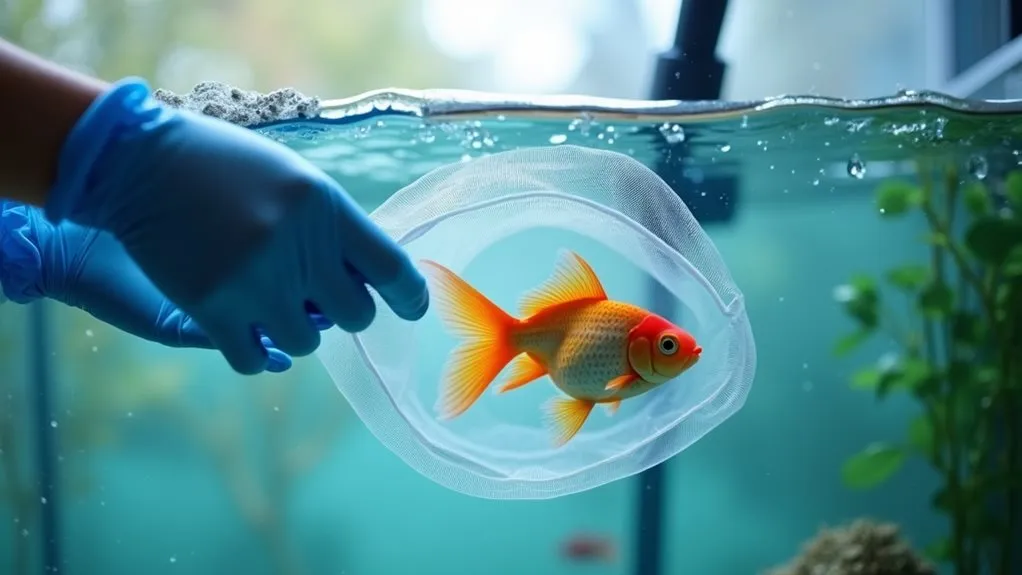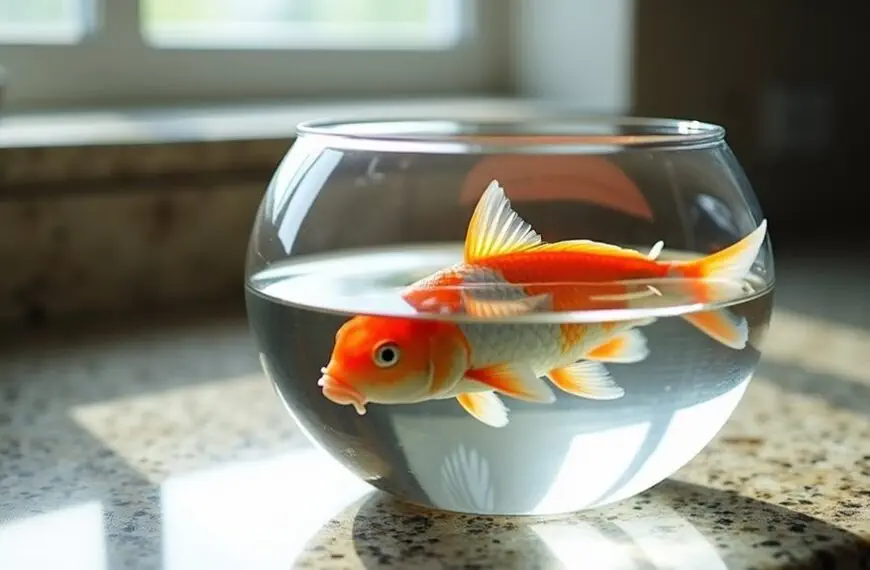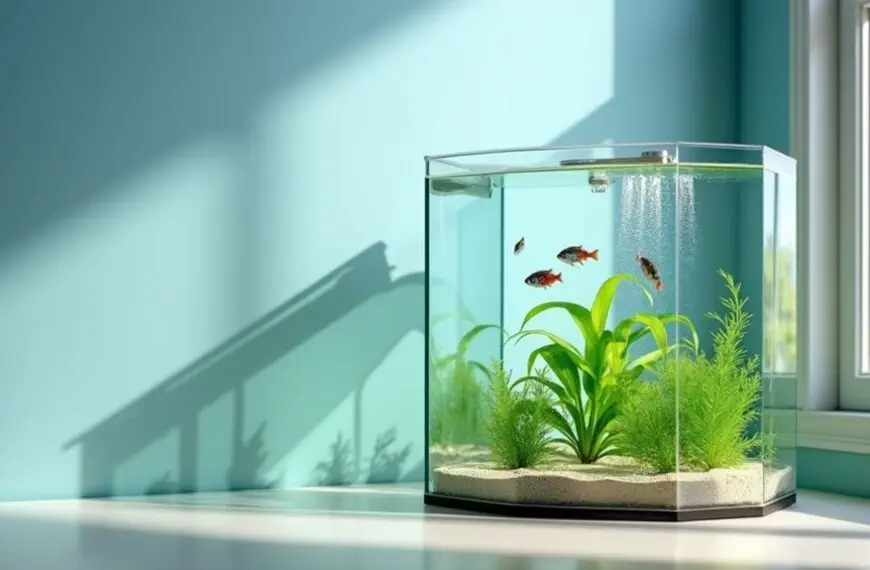You shouldn't remove your fish during routine water changes – keeping them in their familiar environment is actually better for their health and well-being. Taking fish out of the tank causes unnecessary stress, weakens their immune system, and risks physical injury from netting. Instead, focus on performing gentle 10-25% water changes while your fish stay comfortably at home in their tank. Just be sure to match the new water's temperature, use a dechlorinator, and maintain stable water parameters during the process. Your fish will thank you for the spa-like experience, and there's plenty more to learn about keeping your aquatic friends happy and healthy.
Contents
- 1 Why Fish Should Stay Put
- 2 Understanding Water Changes
- 3 Best Practices for Tank Maintenance
- 4 Key Precautions During Water Changes
- 5 Risks of Removing Fish
- 6 Maintaining Tank Ecosystem Balance
- 7 Safe Water Change Methods
- 8 Signs of Successful Water Changes
- 9 Frequently Asked Questions
- 9.1 Can I Feed My Fish Immediately After a Water Change?
- 9.2 How Long Should I Wait Between Consecutive Partial Water Changes?
- 9.3 Should Water Changes Be Done at Specific Times of Day?
- 9.4 Do Different Species of Fish Require Different Water Change Schedules?
- 9.5 Can Aquarium Plants Be Damaged During Routine Water Changes?
- 10 Final Thoughts
Why Fish Should Stay Put
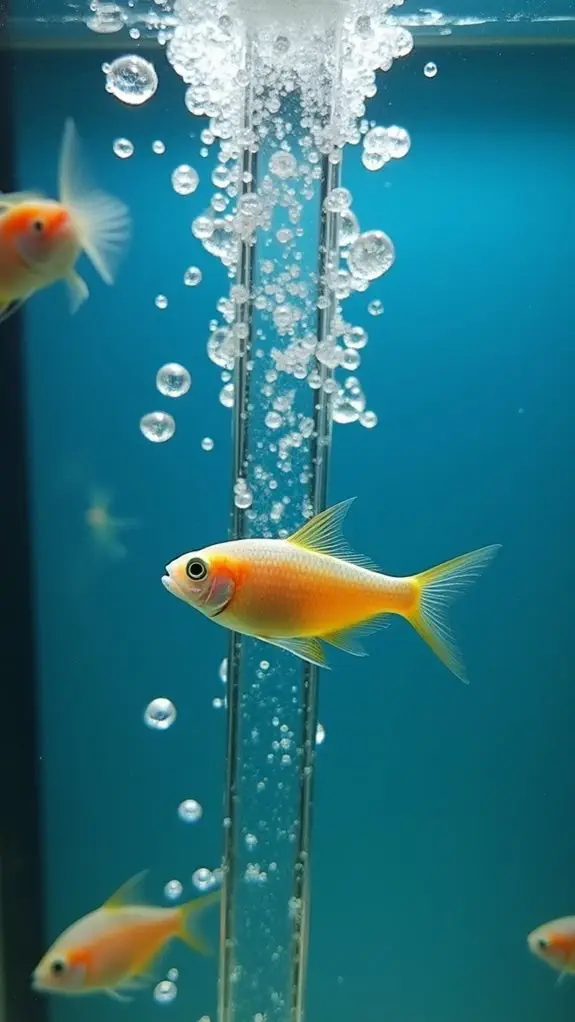
During water changes, keeping your fish in the tank is often the best approach.
When you leave your finned friends in their familiar environment, you'll notice markedly reduced stress levels and more natural fish behavior. It's like asking someone to stay in their comfy home rather than forcing them to temporarily relocate – much less stressful, right? This is vital because maintaining stable water parameters is essential for their well-being.
Using a gravel vacuum cleaner during water changes helps remove debris while allowing fish to stay in place.
Your fish will gradually become accustomed to regular water changes when they remain in the tank, and you'll see them adapt more easily to the maintenance routine. Many fish will show less fear as they become familiar with the regular water change process.
Just remember to match the new water temperature and avoid any sudden movements that might startle them.
Think of it as respecting their personal space while still getting the job done.
Understanding Water Changes
Before you start moving water in and out of your aquarium, you'll want to understand the basics of proper water changes and how they keep your fish healthy.
You're not just replacing dirty water with clean water; you're actually maintaining a complex ecosystem that's home to beneficial bacteria and other microscopic helpers. The best practice is to perform gradual water changes to prevent any shock to your aquatic pets. During these changes, it's important to monitor ammonia levels to ensure they remain safe for your fish.
When you're equipped with the right knowledge about water changes, you'll help your underwater friends thrive while keeping the tank's delicate balance in check. Most aquariums need monthly water changes to maintain optimal conditions for fish health.
Water Change Basics First
Regular water changes are essential for removing waste and maintaining healthy oxygen levels in your tank. If you've got a lightly stocked aquarium, you'll want to change 10-15% of the water weekly, while heavily stocked tanks need about 25%. For those new tanks still finding their balance, you'll need to do this more frequently – about 2-3 times per week. Trace elements naturally deplete in your aquarium over time, making regular changes crucial. Additionally, maintaining optimal water quality through consistent water changes helps ensure a thriving aquatic environment.
Before you start, always prepare your water 24 hours ahead. You'll need to make sure it's dechlorinated and matches your tank's temperature – your fish aren't fans of sudden changes!
Remember to turn off your equipment during the process, and don't go overboard with the amount you change. Keeping it under 50% at any time will help maintain that delicate balance your aquatic pals depend on.
Tank Ecosystem Balance
Understanding your tank's ecosystem takes you beyond basic water changes into the intricate world of aquatic chemistry. Just like a tiny underwater city, your aquarium needs constant management to maintain ecological stability and keep its inhabitants thriving.
Your tank's water chemistry is in a constant state of flux. Every time you feed your fish, natural waste occurs, and chemicals build up – it's just part of the aquarium life cycle. While your filter works hard to process these changes, it can't do everything on its own. A weekly maintenance schedule helps prevent problematic algae blooms from developing. Regular water changes significantly reduce filtration costs by minimizing the need for carbon filtration. That's where regular water changes become your tank's best friend. Additionally, they assist in diluting harmful chemicals that could otherwise compromise your fish's health.
Think of water changes as hitting the reset button on your aquarium's chemical balance. You're not just removing dirty water; you're actively maintaining a stable environment where your fish can flourish.
When you skip water changes, you're allowing harmful compounds to accumulate, which can stress your aquatic friends. Even in tanks with lots of plants and a perfect balance of beneficial bacteria, you'll still need some level of water changes to maintain that delicate equilibrium.
Your fish will thank you with vibrant colors and active behavior!
Best Practices for Tank Maintenance
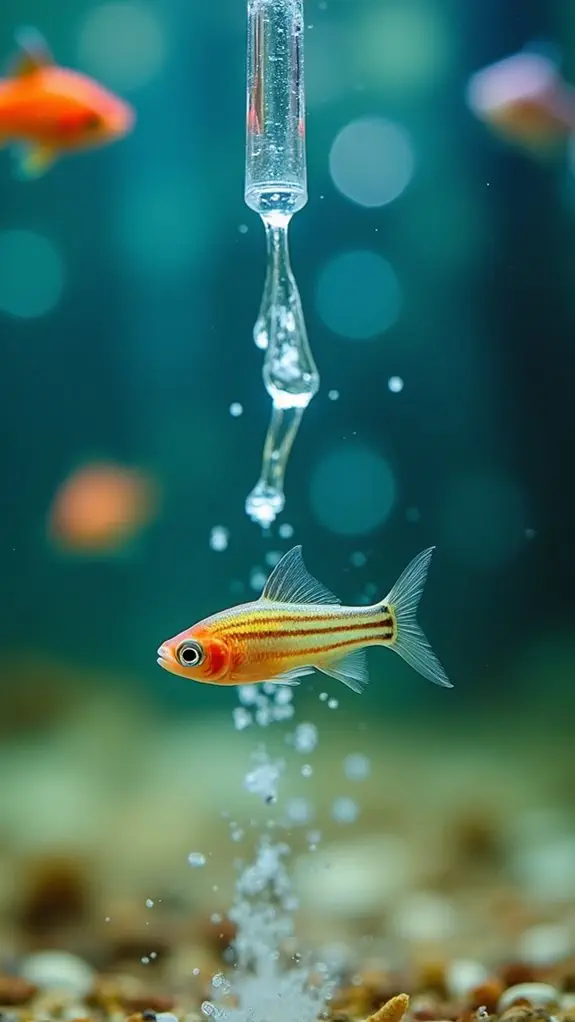
Maintaining a healthy aquarium requires consistent attention to key maintenance practices that support both fish health and water quality. Your tank cleanliness routine should include regular water changes of 10-25%, depending on your tank size, while carefully monitoring fish behavior for any signs of stress during the process. Partial changes help maintain beneficial bacteria in your aquarium ecosystem.
You'll want to establish a weekly maintenance schedule that includes testing water parameters, cleaning the glass, and inspecting equipment. Don't forget to unplug your filters and lights before starting any cleaning tasks – nobody wants an unexpected splash party with electricity involved! The API STRESS COAT will ensure your tap water is safe and healthy for your fish.
Using a gravel vacuum will help you remove debris while simultaneously performing your water change, making the process more efficient. Remember to treat your replacement water with a dechlorinator before adding it to your tank. It's like giving your fish a fresh, clean glass of water rather than serving them tap water straight from the sink!
Keep a maintenance log to track your regular tasks and water test results – you'll thank yourself later when trying to identify patterns or troubleshoot issues. Regular equipment checks and filter maintenance will guarantee your underwater friends stay happy and healthy in their home.
Key Precautions During Water Changes
Safety stands at the forefront of proper aquarium water changes, with electrical hazards being your primary concern. Before you start, unplug all equipment, including heaters and filters, to prevent any risk of electrical shock.
You'll want to be extra careful with heaters, as they can crack if exposed while running.
When it comes to your finned friends, you don't need to remove them during water changes – in fact, it's better if you don't! Fish stress increases considerably when they're netted and moved around. Instead, work slowly with your siphon, maintaining a steady hand to avoid startling your underwater companions.
Your water testing routine is essential during changes. You'll want to keep the new water's temperature and parameters matching your tank's existing conditions. Mix and test the fresh water before adding it, and aim for 10-20% weekly changes to maintain stable conditions. Regular testing of water parameters, such as ammonia levels, is vital to ensure a safe environment for your fish.
Don't forget to use a quality water conditioner to remove harmful chlorine and chloramines from tap water. By following these precautions and using the right equipment, you'll create a safer, more comfortable environment for both you and your fish.
Risks of Removing Fish
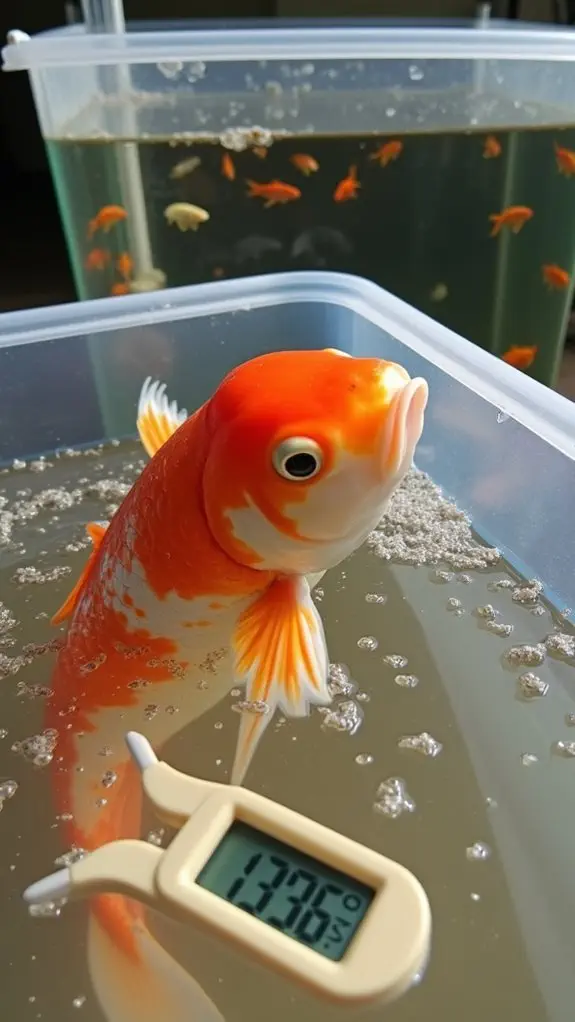
The risks of removing fish from your aquarium extend far beyond simple inconvenience. When you're handling your finned friends during water changes, you're actually exposing them to multiple stressors that can impact their health. Fish stress levels spike dramatically during removal, weakening their immune systems and making them more susceptible to illness.
Your removal techniques play a significant role in your fish's wellbeing. Even with careful handling, you're exposing your aquatic pets to sudden changes in water temperature, pH, and hardness that can shock their systems. Think of it like jumping into a cold pool on a hot day – it's jarring!
Plus, if you're using nets, you'll need to be extra careful as they can cause physical injuries or even internal damage to your fish. Additionally, mistreatment during removal can lead to increased ammonia spikes that further compromise fish health.
The impact doesn't stop at individual fish either. When you remove fish from your tank, you're disrupting the entire ecosystem. Your tank's biological balance can get thrown off, and those beneficial bacteria colonies you've worked so hard to maintain might take a hit. It's like asking your underwater community to restart their neighborhood from scratch!
Maintaining Tank Ecosystem Balance
While fish removal poses risks, proper ecosystem management offers a safer alternative for tank maintenance. By maintaining a balanced tank environment, you'll create ideal conditions for fish behavior and stable water chemistry, making water changes less stressful for your aquatic friends.
Your tank's ecosystem thrives when you follow these key principles:
- Regular 10-20% water changes prevent nitrate buildup while keeping beneficial bacteria happy.
- Consistent pH levels help your fish stay healthy and active.
- Essential minerals get replenished through partial water changes.
- Clean water promotes natural fish behavior and reduces stress.
Think of your aquarium as a miniature underwater world where everything's connected. When you maintain the right balance, your fish will reward you with vibrant colors and playful swimming patterns. Optimal pH levels are essential for overall fish health, so ensure they remain stable during maintenance.
You don't need to remove them during water changes if you're following proper maintenance routines. Instead, focus on regular partial changes that keep the ecosystem stable without disrupting your fish's daily routines.
Remember to test your water parameters regularly and adjust your maintenance schedule based on your specific tank needs, fish population, and filtration system.
Safe Water Change Methods

Before you'll start changing your aquarium's water, you'll need to gather essential equipment like a gravel siphon, clean bucket, and water testing kit.
Performing a water change isn't complicated, but it's important to follow each step carefully, from turning off equipment to matching water temperatures. Regular testing of water parameters, such as ammonia levels, can help ensure a smooth transition during water changes and maintain a healthy environment for your fish.
You'll be amazed at how your fish thrive when you master this simple yet essential tank maintenance routine, which keeps their home clean and healthy while preventing any unexpected stress on your aquatic friends.
Equipment for Safe Changes
Performing safe water changes requires specific equipment to protect both you and your aquatic pets. When it comes to gravel siphon usage, you'll want to invest in a quality vacuum system that efficiently removes debris while maintaining control over the water flow.
Don't forget about proper dechlorination techniques – you'll need a reliable water conditioner to make tap water safe for your finned friends.
Here's what you'll need for successful water changes:
- A gravel vacuum siphon (like the Qanvee) for thorough substrate cleaning
- Dechlorinator (such as Bioactive Tapsafe) to neutralize harmful chemicals
- Clean bucket dedicated to aquarium use only
- Accurate aquarium thermometer for temperature monitoring
Before you start your water change, make sure you've turned off any equipment that might run dry during the process.
You'll want to clean your siphon thoroughly before and after use – nobody likes a dirty tool! When adding new water, remember to match the temperature of your tank to avoid giving your fish an unwanted cold shower. Maintaining optimal water quality is crucial to the health and well-being of your fish.
If you're working with a tropical setup, you might need to warm the new water first. Keep your hands and arms clean, but skip the fancy soaps and lotions that could harm your aquatic pals.
Step-by-Step Water Changing
A successful water change follows four key phases: preparation, removal, replacement, and final checks.
Before you start your water change techniques, you'll need to test the water parameters and gather your supplies, including buckets, a gravel siphon, and dechlorinator.
Don't forget to turn off your equipment – yes, even that trusty heater needs a brief break!
When you're ready to begin, use your gravel siphon to gently remove 10-25% of the water while cleaning the substrate.
You don't want to startle your finned friends, so take it slow and steady.
Remember, we're aiming to minimize fish stress, not create an underwater tornado!
For the replacement phase, you'll want to treat your new water with dechlorinator and guarantee it matches your tank's temperature perfectly. Additionally, ensure that ammonia levels are at 0 ppm before fish are added back to the tank to keep them safe.
Add the water gradually – think of it as giving your fish a gentle rain shower rather than a waterfall experience.
Finally, complete your maintenance by cleaning the filter, removing any debris, and testing the water parameters again.
Keep an eye on your fish for any signs of stress, though if you've followed these steps, they should be swimming happily in their refreshed aquatic home.
Signs of Successful Water Changes
When maintaining an aquarium, identifying successful water changes is essential for your fish's health and the tank's overall stability.
You'll know you're doing things right when your water clarity remains pristine for days without any intervention, and you're seeing effective toxin reduction throughout your system.
Here are key indicators that your water changes are working well:
- Your fish are swimming happily instead of hiding or gasping at the surface
- Test results show zero ammonia and nitrites consistently
- Plants look vibrant and healthy without weird spots or yellowing
- The water stays crystal clear without sudden cloudiness
You'll also notice that regular water changes help keep algae problems at bay, as you're removing excess nutrients that these unwanted guests love to feast on.
If you're maintaining proper schedules (weekly for smaller tanks, biweekly for larger ones) and your fish look active and healthy, you're definitely on the right track.
Remember to match your new water's temperature and always use a dechlorinator – your aquatic friends will thank you by displaying their natural, stress-free behaviors!
Frequently Asked Questions
Can I Feed My Fish Immediately After a Water Change?
Don't feed your fish right after a water change. You'll want to wait 2-3 hours to maintain a proper feeding schedule, as immediate feeding can disrupt fish behavior and cause stress in your aquatic pets.
How Long Should I Wait Between Consecutive Partial Water Changes?
You'll want to wait at least 24 hours between consecutive partial water changes. Monitor your fish health to determine water change frequency, and always test water parameters before performing additional changes.
Should Water Changes Be Done at Specific Times of Day?
You'll get the best results doing water changes when your fish are less active, typically during your tank's night cycle. Consider your fish's behavior patterns and avoid times near feeding or peak activity.
Do Different Species of Fish Require Different Water Change Schedules?
Yes, you'll need different water change schedules based on each species' tolerance and waste production. Some fish require weekly changes to maintain water quality, while others can manage with biweekly or monthly changes.
Can Aquarium Plants Be Damaged During Routine Water Changes?
Yes, your plants can suffer damage during water changes if you don't maintain stable water parameters. Sudden changes in temperature and chemistry can stress plant health, so it's best to make gradual, consistent adjustments.
Final Thoughts
You'll find that keeping your fish in the tank during water changes is usually the best approach. Not only does this reduce stress on your aquatic friends, but it also maintains their natural environment. By following proper water change procedures and monitoring water parameters, you're ensuring a healthier habitat for your fish. Remember, less handling means happier fish, and they'll thank you by continuing to thrive in their well-maintained home.

